A Profile of Organic Food Consumers—Serbia Case-Study
Abstract
1. Introduction
2. Literature Review
- Citizens generally accept the use of mechanized tillage methods better than the use of chemicals;
- Old, known tillage and livestock technologies are more accepted than new, automated ones;
- Conventional reproduction in plant and livestock production is much more desirable than reproduction with the use of genetic modifications;
- Natural methods in food processing are more accepted than modernized, so-called hi-tech food industry.
3. Materials and Methods
- Factors which influence respondents’ food purchase in general;
- Factors pertaining to products’ characteristics;
- Factors pertaining to respondents’ food consumption habits; and
- Sociodemographic characteristics.
4. Results and Discussion
4.1. Consumers Buying Habits
4.2. Factor Analysis
- Component 1: AESTHETICALLY PLEASING AND EASILY RECOGNIZABLE PRODUCT: The product is advertised, of attractive packaging. The manufacturer is well known, it is sold in a pleasant ambience and it looks nice.
- Component 2: HEALTHY AND SAFE PRODUCT: The composition of the product and shelf life are clearly indicated, it does not contain additives, it is environmentally friendly and high quality.
- Component 3: CHEAP PRODUCT: The product is affordable, characterized by the best price-quality ratio and is recommended by friends, experts, nutritionists, doctors.
4.3. Cluster Analysis
- 2.7. I try to be informed about healthy lifestyles.
- 2.1. I consume healthy food products; I care about what gets into my body.
- 2.3. I am careful about the energy value (calories) and fat which I consume.
- 2.5. Packaging plays a significant role when I buy food.
- 2.8. I habitually consume fast food.
- 2.4. I prefer buying food products produced in Serbia.
4.4. Discussion
5. Conclusions
Supplementary Materials
Author Contributions
Funding
Conflicts of Interest
References
- Vapa-Tankosić, J.; Ignjatijević, S.; Kiurski, J.; Milenković, J.; Milojević, I. Analysis of Consumers’ Willingness to Pay for Organic and Local Honey in Serbia. Sustainability 2020, 12, 4686. [Google Scholar] [CrossRef]
- Tomaš-Simin, M.; Glavaš-Trbić, D.; Petrović, M. Organic production in the Republic of Serbia: Economic aspects. Ekon. Teor. Praksa 2019, 12, 88–101. [Google Scholar] [CrossRef]
- Aarset, B.; Beckmann, S.; Bigne, E.; Beveridge, M.; Bjorndal, T.; Bunting, J.; McDonagh, P.; Mariojouls, C.; Muir, J.; Prothero, A.; et al. The European consumers’ understanding and perceptions of the “organic” food regime: The case of aquaculture. Br. Food J. 2004, 106, 93–105. [Google Scholar] [CrossRef]
- Venkat, K. Comparison of Twelve Organic and Conventional Farming Systems: A Life Cycle Greenhouse Gas Emissions Perspective. J. Sustain. Agric. 2012, 36, 620–649. [Google Scholar] [CrossRef]
- Prodanović, R.; Ignjatijević, S.; Bošković, J. Innovative potential of beekeeping production in AP Vojvodina. J. Agron. Technol. Eng. Manag. 2019, 2, 268–277. [Google Scholar]
- Gomiero, T. Food quality assessment in organic vs. conventional agricultural produce: Findings and issues. Appl. Soil Ecol. 2018, 123, 714–728. [Google Scholar] [CrossRef]
- Milošević, G.; Kulić, M.; Đurić, Z.; Đurić, O. The Taxation of Agriculture in the Republic of Serbia as a Factor of Development of Organic Agriculture. Sustainability 2020, 12, 3261. [Google Scholar] [CrossRef]
- Puvača, N.; Lika, E.; Cocoli, S.; ShtyllaKika, T.; Bursić, V.; Vuković, G.; TomašSimin, M.; Petrović, A.; Cara, M. Use of Tea Tree Essential Oil (Melaleucaalternifolia) in Laying Hen’s Nutrition on Performance and Egg Fatty Acid Profile as a Promising Sustainable Organic Agricultural Tool. Sustainability 2020, 12, 3420. [Google Scholar] [CrossRef]
- Sarkar, A.N. Green Branding and Eco-innovations for Evolving a Sustainable Green Marketing Strategy. Asia-Pac. J. Manag. Res. Innov. 2012, 8, 39–58. [Google Scholar] [CrossRef]
- Fernando, Y.; ChiappettaJabbour, C.J.; Wah, W.-X. Pursuing green growth in technology firms through the connections between environmental innovation and sustainable business performance: Does service capability matter? Resour. Conserv. Recycl. 2019, 141, 8–20. [Google Scholar] [CrossRef]
- Peattie, K. Towards Sustainability: The Third Age of Green Marketing. Mark. Rev. 2001, 2, 129–146. [Google Scholar] [CrossRef]
- Simula, H.; Lehtimäki, T. Managing greenness in technology marketing. J. Syst. Inf. Tech. 2009, 11, 331–346. [Google Scholar] [CrossRef]
- Feil, A.A.; da Cyrne, C.C.S.; Sindelar, F.C.W.; Barden, J.E.; Dalmoro, M. Profiles of sustainable food consumption: Consumer behavior toward organic food in southern region of Brazil. J. Clean. Prod. 2020, 258, 120690. [Google Scholar] [CrossRef]
- Falguera, V.; Aliguer, N.; Falguera, M. An integrated approach to current trends in food consumption: Moving toward functional and organic products? Food Control 2012, 26, 274–281. [Google Scholar] [CrossRef]
- Hansmann, R.; Baur, I.; Binder, C.R. Increasing organic food consumption: An integrating model of drivers and barriers. J. Clean. Prod. 2020, 275, 123058. [Google Scholar] [CrossRef]
- Chekima, B.; Oswald, A.I.; Wafa, S.A.W.S.K.; Chekima, K. Narrowing the gap: Factors driving organic food consumption. J. Clean. Prod. 2017, 166, 1438–1447. [Google Scholar] [CrossRef]
- Chekima, B.; Chekima, K.; Chekima, K. Understanding factors underlying actual consumption of organic food: The moderating effect of future orientation. Food Qual. Prefer. 2019, 74, 49–58. [Google Scholar] [CrossRef]
- Vehapi, S. A study of the consumer Motives which influence the purchase of organic food in serbia. Ekon. Teme 2015, 53, 105–121. [Google Scholar] [CrossRef]
- Grubor, A.; Djokić, N. Organic food consumer profile in the Republic of Serbia. Br. Food J. 2016, 118, 164–182. [Google Scholar] [CrossRef]
- Tomaš-Simin, M.; Glavaš-Trbić, D. Historical development of organic production. Ekon. Polj. 2016, 63, 1083–1099. [Google Scholar] [CrossRef]
- Shabbir, M.S.; Bait Ali Sulaiman, M.A.; Hasan Al-Kumaim, N.; Mahmood, A.; Abbas, M. Green Marketing Approaches and Their Impact on Consumer Behavior towards the Environment—A Study from the UAE. Sustainability 2020, 12, 8977. [Google Scholar] [CrossRef]
- Lotter, D.W. Organic Agriculture. J. Sustain. Agric. 2003, 21, 59–128. [Google Scholar] [CrossRef]
- Margetts, B.M.; Martinez, J.A.; Saba, A.; Holm, L.; Kearney, M.; Moles, A. Definitions of “healthy” eating: A pan-EU survey of consumer attitudes to food, nutrition and health. Eur. J. Clin. Nutr. 1997, 51 (Suppl. 2), S23. [Google Scholar] [PubMed]
- Torjusen, H.; Lieblein, G.; Wandel, M.; Francis, C.A. Food system orientation and quality perception among consumers and producers of organic food in Hedmark County, Norway. Food Qual. Prefer. 2001, 12, 207–216. [Google Scholar] [CrossRef]
- Wier, M.; O’Doherty Jensen, K.; Andersen, L.M.; Millock, K. The character of demand in mature organic food markets: Great Britain and Denmark compared. Food Policy 2008, 33, 406–421. [Google Scholar] [CrossRef]
- Gracia, A.; de Magistris, T. The demand for organic foods in the South of Italy: A discrete choice model. Food Policy 2008, 33, 386–396. [Google Scholar] [CrossRef]
- Garg, N.; Wansink, B.; Inman, J.J. The Influence of Incidental Affect on Consumers’ Food Intake. J. Mark. 2007, 71, 194–206. [Google Scholar] [CrossRef]
- Nie, C.; Zepeda, L. Lifestyle segmentation of US food shoppers to examine organic and local food consumption. Appetite 2011, 57, 28–37. [Google Scholar] [CrossRef]
- Van Huy, L.; Chi, M.; Lobo, A.; Nguyen, N.; Long, P. Effective Segmentation of Organic Food Consumers in Vietnam Using Food-Related Lifestyles. Sustainability 2019, 11, 1237. [Google Scholar] [CrossRef]
- Migliore, G.; Thrassou, A.; Crescimanno, M.; Schifani, G.; Galati, A. Factors affecting consumer preferences for “natural wine”: An exploratory study in the Italian market. BFJ 2020, 122, 2463–2479. [Google Scholar] [CrossRef]
- Drugova, T.; Curtis, K.R.; Akhundjanov, S.B. Organic wheat products and consumer choice: A market segmentation analysis. BFJ 2020, 122, 2341–2358. [Google Scholar] [CrossRef]
- Pacho, F. What influences consumers to purchase organic food in developing countries? BFJ 2020, 122, 3695–3709. [Google Scholar] [CrossRef]
- Troudi, H.; Bouyoucef, D. Predicting purchasing behavior of green food in Algerian context. EMJB 2020, 15, 1–21. [Google Scholar] [CrossRef]
- Nair, S.R.; Shams, S.M.R. Impact of store-attributes on food and grocery shopping behavior: Insights from an emerging market context. EMJB 2020. [Google Scholar] [CrossRef]
- Wang, X.; Pacho, F.; Liu, J.; Kajungiro, R. Factors Influencing Organic Food Purchase Intention in Developing Countries and the Moderating Role of Knowledge. Sustainability 2019, 11, 209. [Google Scholar] [CrossRef]
- Frewer, L.J.; Risvik, E.; Schifferstein, H. (Eds.) Food, People and Society; Springer: Berlin/Heidelberg, Germany, 2001; ISBN 978-3-642-07477-6. [Google Scholar]
- Vandal, K. Trženje s sonarovnimikmetijskimipridelki. Sodobno Kmetijstvo 1997, 30, 363–369. [Google Scholar]
- Grunert, S.C.; Juhl, H.J. Values, environmental attitudes, and buying of organic foods. J. Econ. Psychol. 1995, 16, 39–62. [Google Scholar] [CrossRef]
- Weiner, M. Cradle to Cradle@_ An analysis of the market potential in the German outdoor apparel industry. Bachelor’s Thesis, Hochschule Hannover University of Applied Sciences and Arts, Hanover, Germany, 2016. [Google Scholar]
- Yang, S.; Angulo, F.J.; Altekruse, S.F. Evaluation of Safe Food-Handling Instructions on Raw Meat and Poultry Products. J. Food Prot. 2000, 63, 1321–1325. [Google Scholar] [CrossRef]
- Fotopoulos, C.; Chryssochoidis, G.M.; Pantzios, C.J. Critical factors affecting the future of the Greek market of organic produce. Mediterr. J. Econ.Agric. Environ. 1999, 10, 30–35. [Google Scholar]
- MacRae, R.J.; Lynch, D.; Martin, R.C. Improving Energy Efficiency and GHG Mitigation Potentials in Canadian Organic Farming Systems. J. Sustain. Agric. 2010, 34, 549–580. [Google Scholar] [CrossRef]
- Magnusson, M.K.; Arvola, A.; Hursti, U.-K.K.; Åberg, L.; Sjödén, P.-O. Choice of organic foods is related to perceived consequences for human health and to environmentally friendly behaviour. Appetite 2003, 40, 109–117. [Google Scholar] [CrossRef]
- Lockie, S.; Lyons, K.; Lawrence, G.; Grice, J. Choosing organics: A path analysis of factors underlying the selection of organic food among Australian consumers. Appetite 2004, 43, 135–146. [Google Scholar] [CrossRef] [PubMed]
- Tsakiridou, E.; Boutsouki, C.; Zotos, Y.; Mattas, K. Attitudes and behaviour towards organic products: An exploratory study. Int. J. Retail. Distrib. Manag. 2008, 36, 158–175. [Google Scholar] [CrossRef]
- Ness, M.R.; Ness, M.; Brennan, M.; Oughton, E.; Ritson, C.; Ruto, E. Modelling consumer behavioural intentions towards food with implications for marketing quality low-input and organic food. Food Qual. Prefer. 2010, 21, 100–111. [Google Scholar] [CrossRef]
- Stolz, H.; Stolze, M.; Hamm, U.; Janssen, M.; Ruto, E. Consumer attitudes towards organic versus conventional food with specific quality attributes. NJAS Wagening. J. Life Sci. 2011, 58, 67–72. [Google Scholar] [CrossRef]
- Ignjatijević, S.; Prodanović, R.; Bošković, J.; Puvača, N.; Tomaš-Simin, M.; Peulić, T.; Đuragić, O. Comparative analysis of honey consumption in Romania, Italy and Serbia. Food Feed Res. 2019, 46, 125–136. [Google Scholar] [CrossRef]
- Brkanlić, S.; Sánchez-García, J.; Esteve, E.B.; Brkić, I.; Ćirić, M.; Tatarski, J.; Gardašević, J.; Petrović, M. Marketing Mix Instruments as Factors of Improvement of Students’ Satisfaction in Higher Education Institutions in Republic of Serbia and Spain. Sustainability 2020, 12, 7802. [Google Scholar] [CrossRef]
- Tatarski, J.; Brkanlić, S.; Sanchez Garcia, J.; Esteve, E.B.; Brkić, I.; Petrović, M.; Okanović, A. Measuring Entrepreneurial Orientation of University Employees in Developing Countries Using the ENTRE-U Scale. Sustainability 2020, 12, 8911. [Google Scholar] [CrossRef]
- National Research Council (US); Institute of Medicine (US); Woolf, S.H.; Aron, L. Public Health and Medical Care Systems; National Academies Press: Washington, DC, USA, 2013. [Google Scholar]
- Scaglioni, S.; De Cosmi, V.; Ciappolino, V.; Parazzini, F.; Brambilla, P.; Agostoni, C. Factors Influencing Children’s Eating Behaviours. Nutrients 2018, 10, 706. [Google Scholar] [CrossRef]
- Canio Francesca, D.; Elisa, M. EU quality label vs Organic food products: A multigroup structural equation modeling to assess consumers’ intention to buy in light of sustainable motives. Food Res. Int. 2020, 109846, In Press, Corrected Proof. [Google Scholar] [CrossRef]
- Ditlevsen, K.; Denver, S.; Christensen, T.; Lassen, J. A taste for locally produced food—Values, opinions and sociodemographic differences among ‘organic’ and ‘conventional’ consumers. Appetite 2020, 147, 104544. [Google Scholar] [CrossRef] [PubMed]
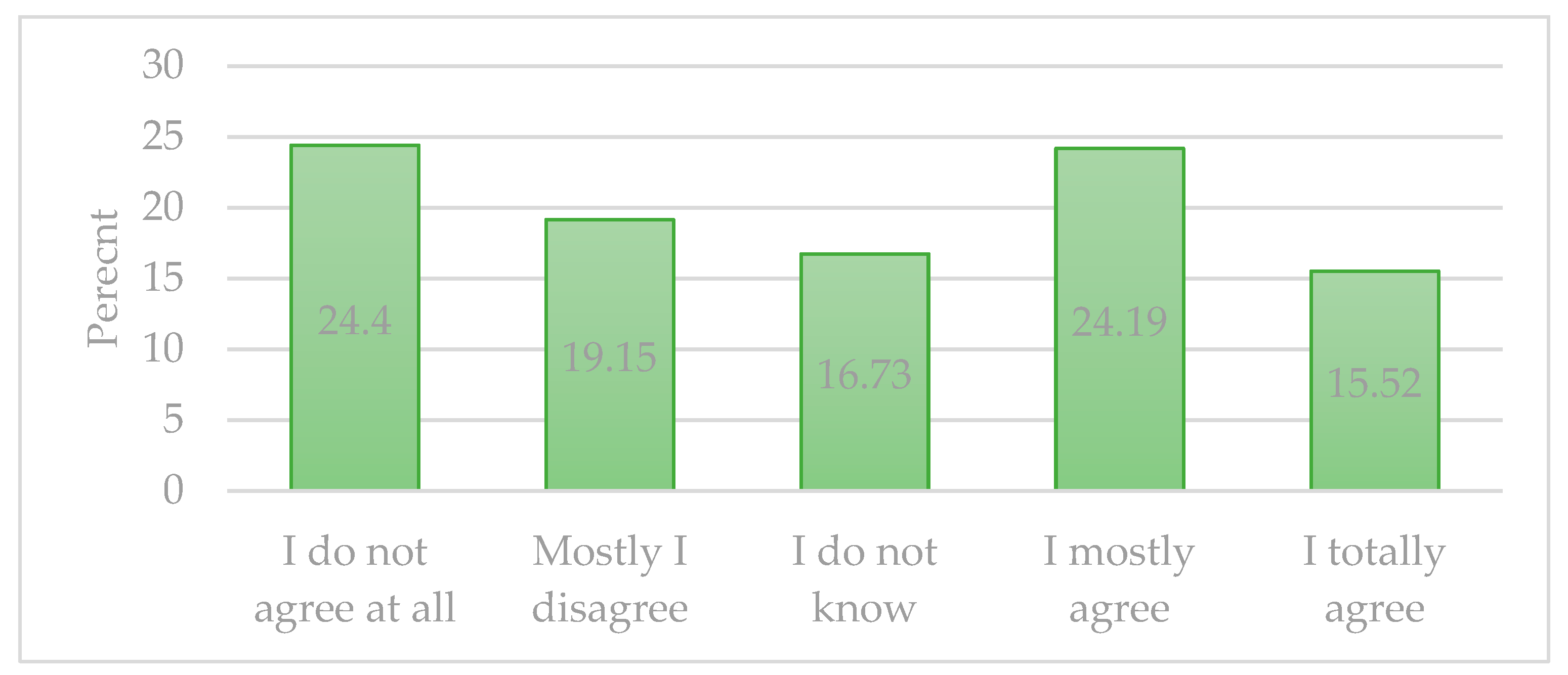
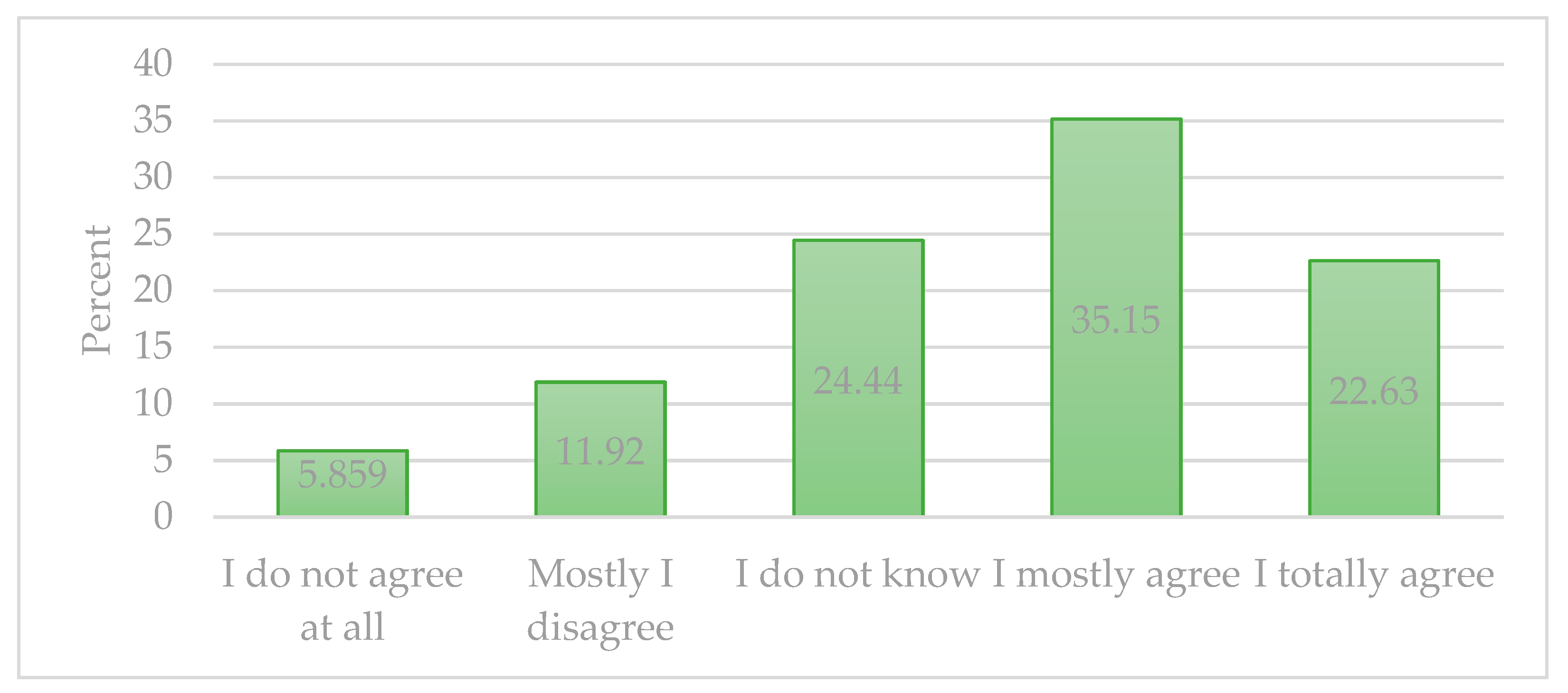
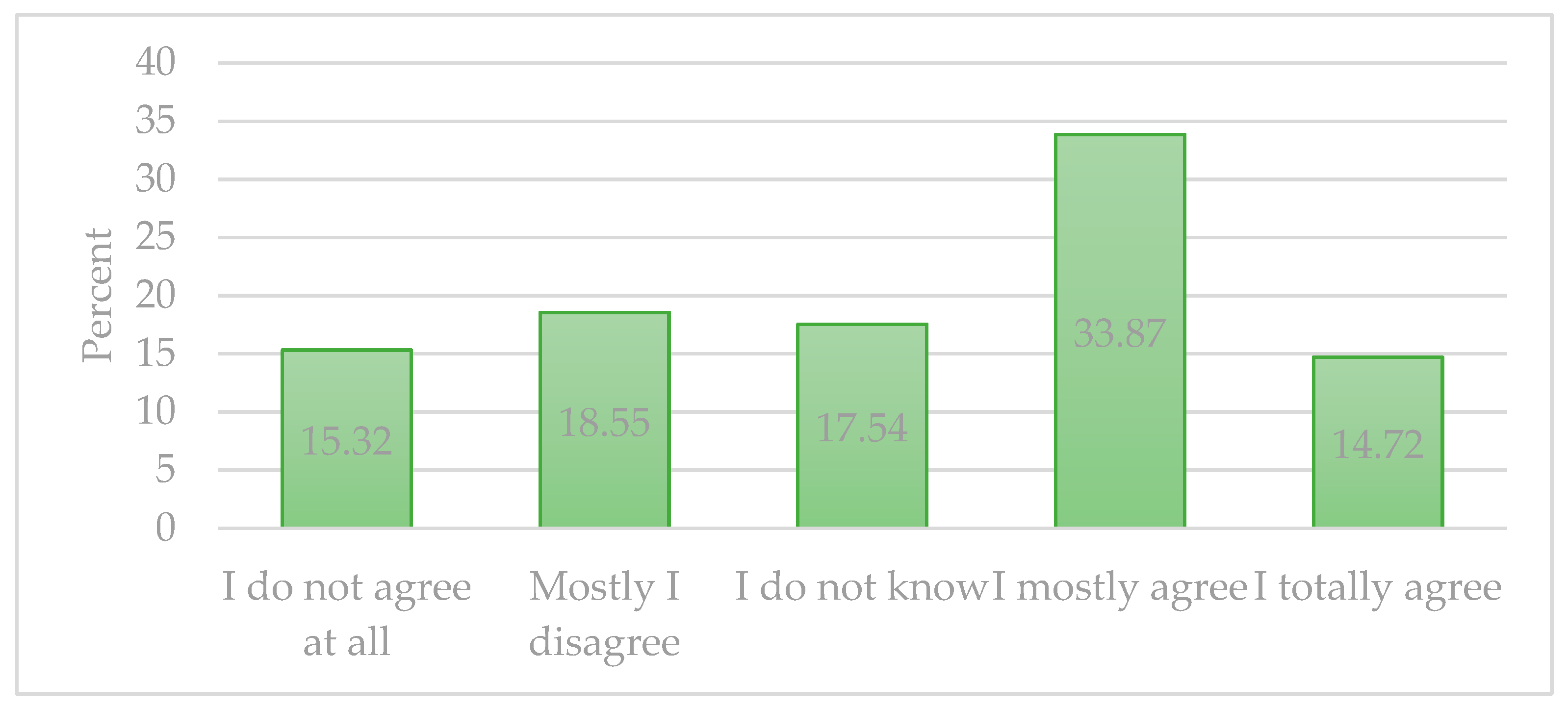
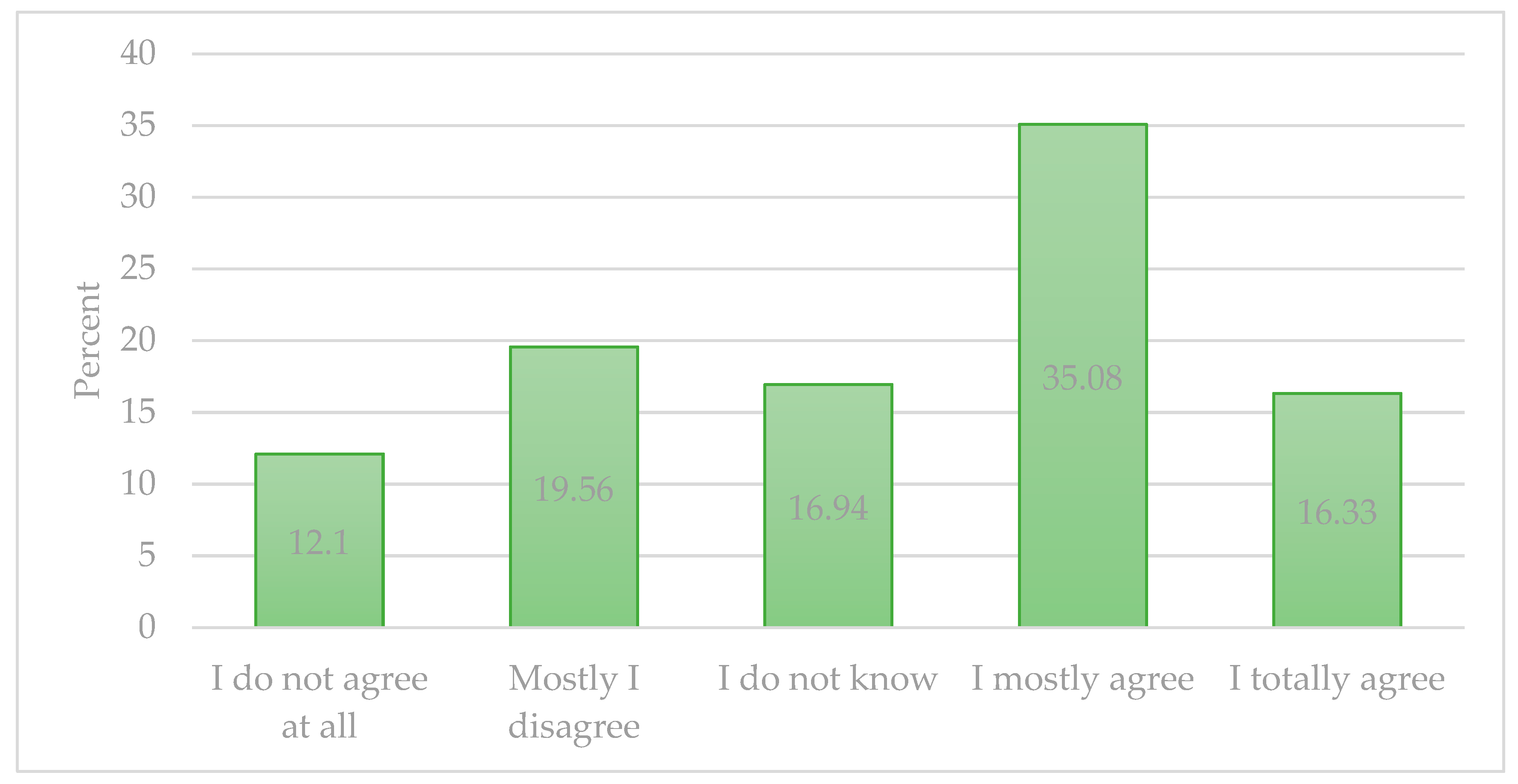
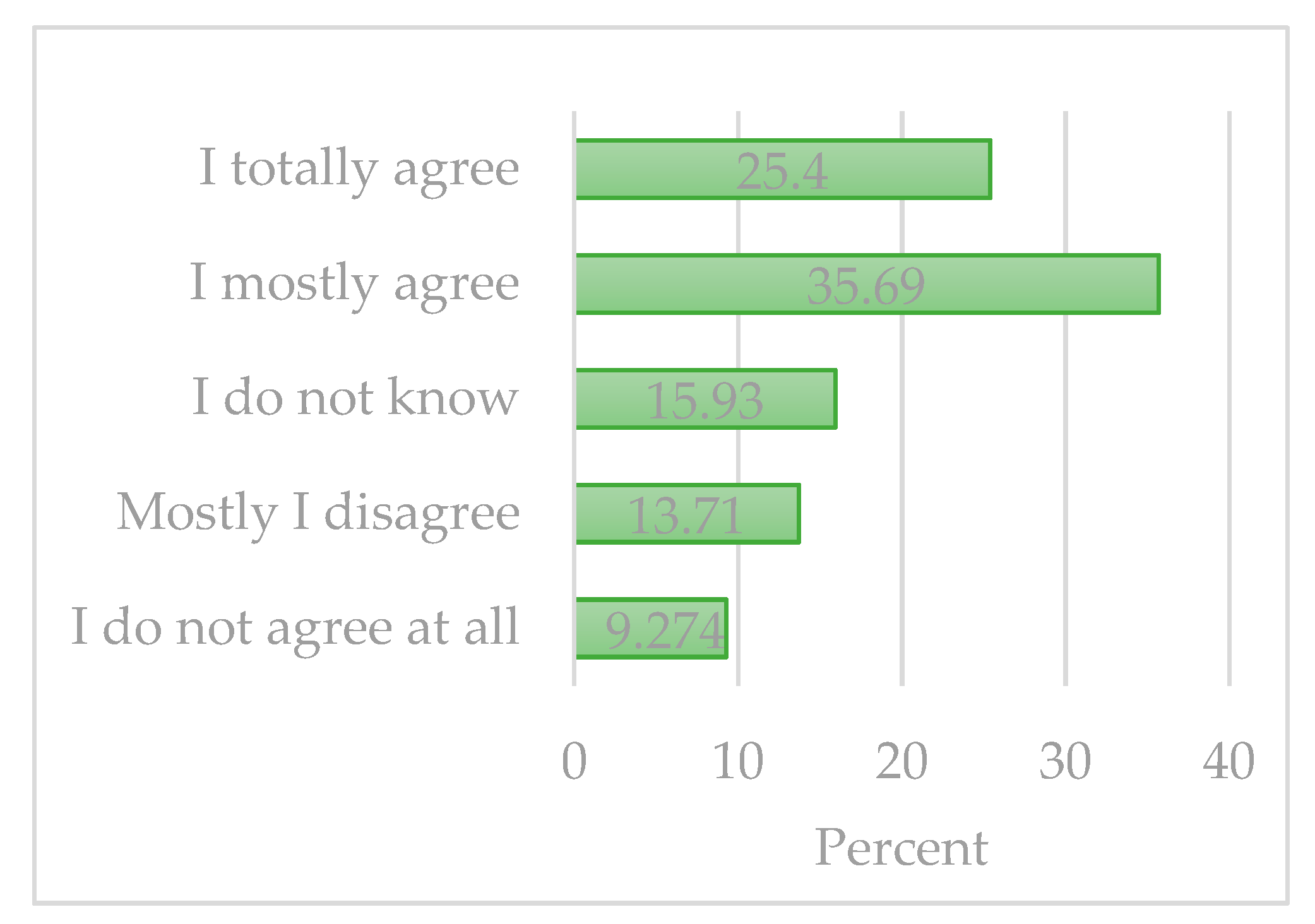
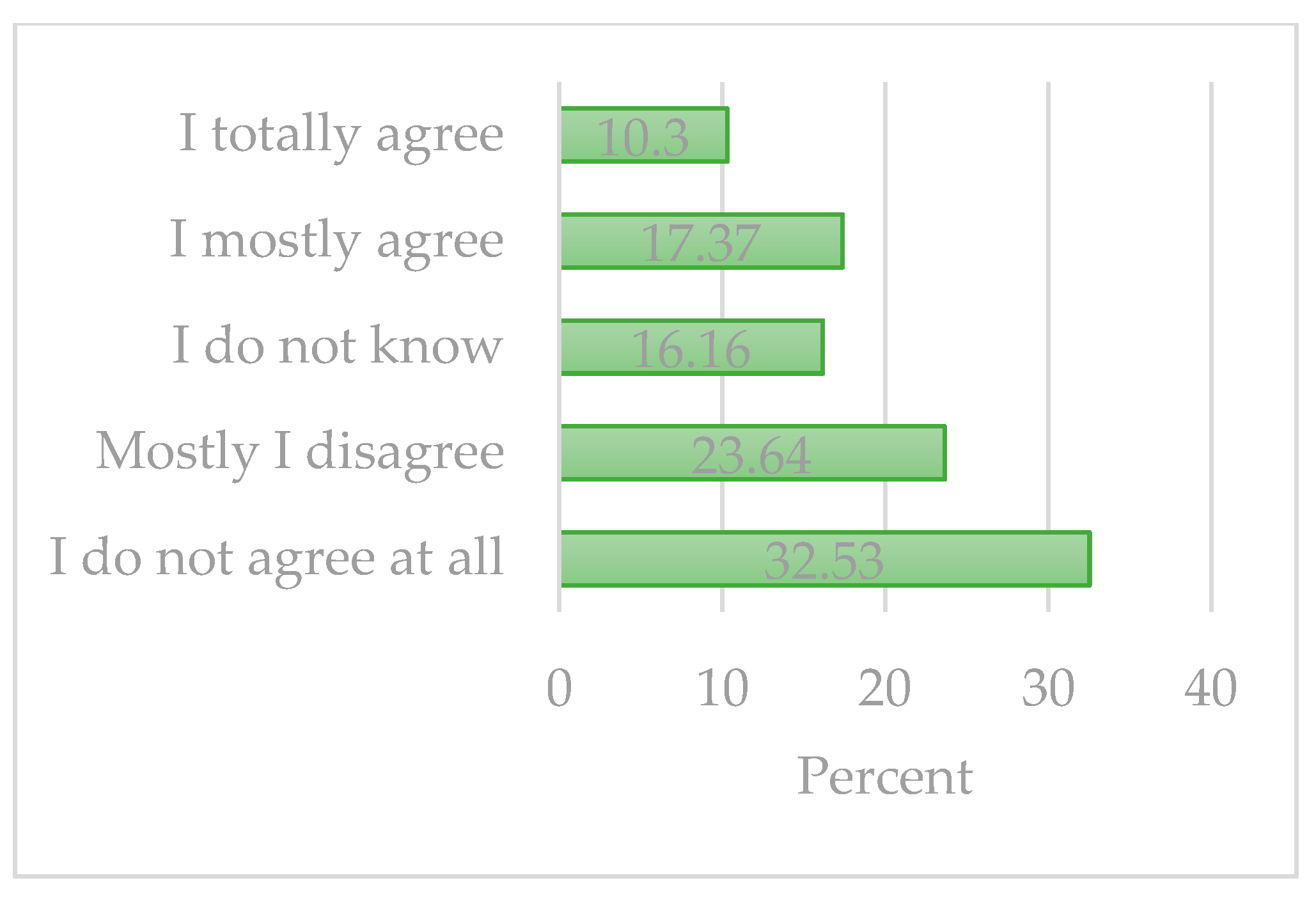
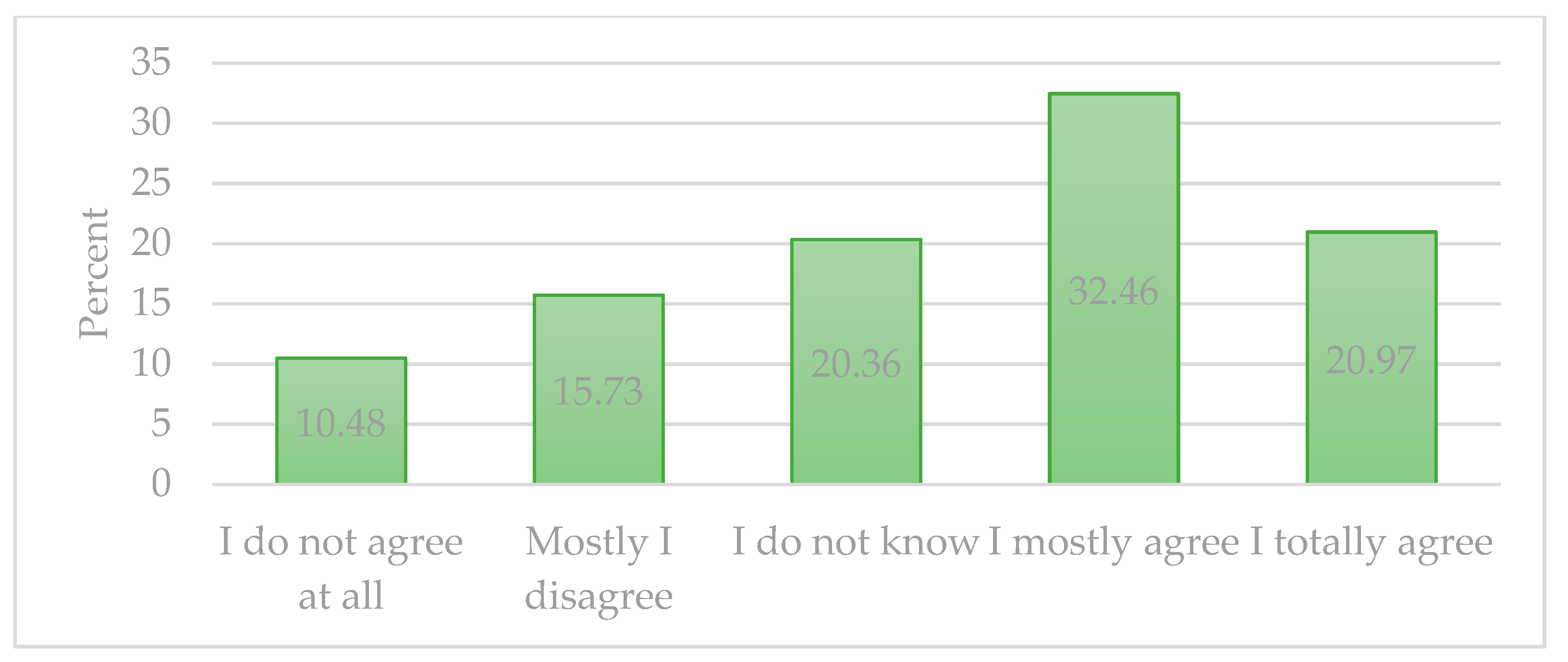
| On the Scale from 1 to 5, Indicate to What Extent You Agree with the Following Statements * | ||||||
|---|---|---|---|---|---|---|
| 1 | I consume healthy food products; I care about what gets into my body | 1 | 2 | 3 | 4 | 5 |
| 2 | Imported food products are of better quality | 1 | 2 | 3 | 4 | 5 |
| 3 | I am careful about the energy value (calories) and fat which I consume | 1 | 2 | 3 | 4 | 5 |
| 4 | I prefer buying food products produced in Serbia | 1 | 2 | 3 | 4 | 5 |
| 5 | Packaging plays a significant role when I buy food | 1 | 2 | 3 | 4 | 5 |
| 6 | My diet consists mainly of fresh produce | 1 | 2 | 3 | 4 | 5 |
| 7 | I try to be informed about healthy lifestyles | 1 | 2 | 3 | 4 | 5 |
| 8 | I habitually consume fast food | 1 | 2 | 3 | 4 | 5 |
| 9 | Conservation of nature and living in accordance with nature are important to me | 1 | 2 | 3 | 4 | 5 |
| Description | Data | ||||||
| Kaiser–Meyer–Olkin Measure of Sampling Adequacy | 0.756 | ||||||
| Bartlett’s Test of Sphericity | Approx. Chi-Square | 1425.032 | |||||
| df | 0.91 | ||||||
| Sig. | 0 | ||||||
| Component | Initial value | The sum of squares loading | Rotation sums of squares loadings | ||||
| Total | Variance | Cumulative | Total | Variance | Cumulative | ||
| 1 | 3.455 | 24.676 | 24.676 | 3.455 | 24.676 | 24.676 | 2.444 |
| 2 | 1.792 | 12.801 | 37.477 | 1.792 | 12.801 | 37.477 | 2.509 |
| 3 | 1.54 | 11.003 | 48.48 | 1.54 | 11.003 | 48.48 | 1.487 |
| 4 | 1.058 | 7.559 | 56.039 | 1.058 | 7.559 | 56.039 | 2.157 |
| 5 | 0.946 | 6.761 | 62.8 | ||||
| 6 | 0.783 | 5.596 | 68.396 | ||||
| 7 | 0.735 | 5.247 | 73.644 | ||||
| 8 | 0.682 | 4.873 | 78.516 | ||||
| 9 | 0.661 | 4.722 | 83.238 | ||||
| 10 | 0.577 | 4.125 | 87.363 | ||||
| 11 | 0.518 | 3.702 | 91.065 | ||||
| 12 | 0.472 | 3.373 | 94.438 | ||||
| 13 | 0.42 | 2.997 | 97.435 | ||||
| 14 | 0.359 | 2.565 | 100 | ||||
| Question | Component | ||||||
| 1 | 2 | 3 | 4 | ||||
| 1.8 On a scale of 1 to 5, rate how much the product advertisement affects your decision when buying food products. | 0.814 | ||||||
| 1.9 On a scale of 1 to 5, rate the fact that the manufacturer is knowninfluences your decision when buying food products. | 0.697 | ||||||
| 1.7 On a scale of 1 to 5, rate how much recommendations (friends, experts, nutritionist, doctor) influence your decision when buying food products. | 0.636 | ||||||
| 1.10 On a scale of 1 to 5, evaluate how clearly written the composition of the packaging influences your decision when buying food product. | 0.77 | ||||||
| 1.4 On a scale of 1 to 5, evaluate how much the product does not contain additives and harmful substances affects your purchase decision food products. | 0.706 | ||||||
| 1.5 On a scale of 1 to 5, assess how clearly indicated the shelf life of the product influences your decision when buying food products. | 0.663 | ||||||
| 1.13 On a scale of 1 to 5, rate the fact that the product is environmentally friendly (bio) influences your decision when buying food products. | 0.505 | ||||||
| 1.6 On a scale of 1 to 5, evaluate how much the favorable price of the product affects your decision when buying food. | 0.827 | ||||||
| 1.14 On a scale of 1 to 5, rate the best value for money the product influences your decision when buying food products. | 0.786 | ||||||
| 1.12 On a scale of 1 to 5, rate the fact that the product looks nice influences your decision when buying food products. | 0.788 | ||||||
| 1.11 On a scale of 1 to 5, rate how pleasant the environment in which the product is sold influences your decision when buying food products. | 0.63 | ||||||
| Component | Initial Value | The Sum of Squares Loading | Rotation Sums of Squares Loadings | ||||
|---|---|---|---|---|---|---|---|
| Total | Variance | Cumulative | Total | Variance | Cumulative | ||
| 1 | 3.455 | 24.676 | 24.676 | 3.455 | 24.676 | 24.676 | 2.978 |
| 2 | 1.792 | 12.801 | 37.477 | 1.792 | 12.801 | 37.477 | 2.648 |
| 3 | 1.540 | 11.003 | 48.480 | 1.540 | 11.003 | 48.480 | 1.606 |
| 4 | 1.058 | 7.559 | 56.039 | ||||
| 5 | 0.946 | 6.761 | 62.800 | ||||
| 6 | 0.783 | 5.596 | 68.396 | ||||
| 7 | 0.735 | 5.247 | 73.644 | ||||
| 8 | 0.682 | 4.873 | 78.516 | ||||
| 9 | 0.661 | 4.722 | 83.238 | ||||
| 10 | 0.577 | 4.125 | 87.363 | ||||
| 11 | 0.518 | 3.702 | 91.065 | ||||
| 12 | 0.472 | 3.373 | 94.438 | ||||
| 13 | 0.420 | 2.997 | 97.435 | ||||
| 14 | 0.359 | 2.565 | 100.000 | ||||
| Question | Component | |||
| 1 | 2 | 3 | 4 | |
| 1.8 On a scale of 1 to 5, rate how much the product advertisement affects your decision when buying food products. | 0.780 | |||
| 1.3 On a scale of 1 to 5, evaluate how attractive the product packaging is on your decision when buying food products. | 0.737 | |||
| 1.9 On a scale of 1 to 5, rate the fact that the manufacturer is known influences your decision when buying food products. | 0.710 | |||
| 1.11 On a scale of 1 to 5, rate how pleasant the environment in which the product is sold influences your decision when buying food products. | 0.657 | |||
| 1.12 On a scale of 1 to 5, rate the fact that the product looks nice influences your decision when buying food products. | 0.594 | |||
| 1.10 On a scale of 1 to 5, evaluate how clearly written the composition of the packaging influences your decision when buying food product. | 0.764 | |||
| 1.4 On a scale of 1 to 5, evaluate how much the product does not contain additives and harmful substances affects your purchase decision food products. | 0.754 | |||
| 1.5 On a scale of 1 to 5, assess how clearly indicated the shelf life of the product influences your decision when buying food products. | 0.636 | |||
| 1.2 On a scale of 1 to 5, assess how much the origin of the product affects your decision when buying food products. | 0.302 | 0.521 | ||
| 1.13 On a scale of 1 to 5, rate the fact that the product is environmentally friendly (bio) influences your decision when buying food products. | 0.511 | |||
| 1.1 On a scale of 1 to 5, evaluate how much the quality of the product affects your decision when buying food products. | 0.464 | |||
| 1.14 On a scale of 1 to 5, rate the best value for money the product influences your decision when buying food products. | 0.757 | |||
| 1.6 On a scale of 1 to 5, evaluate how much the favorable price of the product affects your decision when buying food. | 0.755 | |||
| 1.7 On a scale of 1 to 5, rate how much recommendations (friends, experts, nutritionist, doctor) influence your decision when buying food products. | 0.319 | 0.351 | ||
| Iterations | Variations between Cluster Means * | ||
|---|---|---|---|
| 1 | 2 | 3 | |
| 1 | 2.948 | 3.282 | 3.266 |
| 2 | 0.295 | 0.303 | 0.315 |
| 3 | 0.101 | 0.115 | 0.167 |
| 4 | 0.054 | 0.077 | 0.088 |
| 5 | 0.053 | 0.036 | 0.095 |
| 6 | 0.031 | 0.079 | 0.096 |
| 7 | 0.023 | 0.108 | 0.107 |
| 8 | 0.032 | 0.119 | 0.154 |
| 9 | 0.065 | 0.110 | 0.160 |
| 10 | 0.060 | 0.080 | 0.116 |
| 11 | 0.039 | 0.033 | 0.073 |
| 12 | 0.026 | 0.000 | 0.033 |
| 13 | 0.000 | .0000 | 0.000 |
| Description | Number of Clusters | Number of Respondents |
|---|---|---|
| Cluster | 1 | 204.000 |
| 2 | 134.000 | |
| 3 | 155.000 | |
| Valid | 493.000 | |
| Not valid | 3.000 | |
| Iterations | Variations between Cluster Means | ||
|---|---|---|---|
| 1 | 2 | 3 | |
| 1 | 2.388 | 2.200 | 2.331 |
| 2 | 0.267 | 0.232 | 0.399 |
| 3 | 0.121 | 0.135 | 0.243 |
| 4 | 0.076 | 0.093 | 0.133 |
| 5 | 0.092 | 0.061 | 0.130 |
| 6 | 0.032 | 0.049 | 0.077 |
| 7 | 0.017 | 0.034 | 0.055 |
| 8 | 0.017 | 0.000 | 0.011 |
| 9 | 0.000 | 0.000 | 0.000 |
| Description | Number of Clusters | Number of Respondents |
|---|---|---|
| Cluster | 1 | 105.000 |
| 2 | 222.000 | |
| 3 | 167.000 | |
| Valid | 494.000 | |
| Not valid | 2.000 | |
| Cluster 1: This group consists mainly of respondents who are over 35 years of age, single or married, have one household member and a lower level of education, and are tradesmen or blue-collar workers. Of least importance to them is whether they consume healthy products and the number of calories those products have. When purchasing products, it is of least importance to them whether the products are environmentallyfriendly or not. A clearly marked expiration date is an equally insignificant factor, and that constitutes the largest difference between this cluster and the other two clusters. In addition, they do not assign any importance to the origin of products, packaging, or a pleasant setting in which the product is sold. When buying food items, respondents in this cluster pay attention to getting value for money, and the most important factor which influences their decision is product price. | Component 3: CHEAP PRODUCT: The product is reasonably priced or sold at a bargain price; it is good value for money and it is recommended by a friend, expert, nutritionist, doctor. | |
| Cluster 2: This group consists of respondents who are under 45 years of age, with most of them between 25 and 34, single or married, (but this cluster has a higher number of divorced people than either Cluster 1 or Cluster 3), and have 2–4 household members. Regarding the level of education, most respondents in this cluster have high school or university education. They are mostly tradesmen, engineers, and professionals, with the largest number of professionals. When compared with the other two clusters, respondents in this cluster pay most attention to what they consume and they want to be informed about healthy lifestyles. Factors which they find important when purchasing food items include: quality, recommendation, marketing, renowned manufacturer, aesthetic, and a pleasant setting in which the products is sold. The importance they assign to these factors sets this group starkly apart from Cluster 1 and Cluster 3. The least important factor to this group is product origin, but they still assign more importance to it than Clusters 1 and 3. The two most important factors to this group are product quality and a clearly marked expiration date. | Component 1: AESTHETICALLY PLEASING AND EASILY RECOGNISABLE PRODUCT: The product is well-marketed, attractively packaged. It is produced by a renowned manufacturer, sold in a pleasant setting, and looks nice. | Component 2: HEALTHY AND SAFE PRODUCT: Ingredients and the expiration date are clearly stated; the product does not contain additives, it is eco-friendly, and of good quality. |
| Cluster 3: This group consists of respondents between 25 and 54 years of age, predominantly single or married, with 3 or 4 household members. Level of education of this group is similar to that of Cluster 2, that is, most respondents in this group have high school or university education. This group is similar to the previous one with regard to occupations, too, but engineers are prevalent in this cluster. Respondents in this cluster think that it is important to eat “healthy” food, but they pay less attention to product origin than either Cluster 1 or 2. Regarding factors which influence purchase of food items, it is important to them that the product is eco-friendly and has a clearly marked expiration date, and the most important factor is product quality. Respondents in this group do not assign importance to recommendations and product aesthetics. This sets them apart from Clusters 1 and 2. In addition, respondents in this cluster do not assign importance to marketing and packaging. | Component 2: HEALTHY AND SAFE PRODUCT: Ingredients and the expiration date are clearly stated; the product does not contain additives; it is eco-friendly and of good quality. |
Publisher’s Note: MDPI stays neutral with regard to jurisdictional claims in published maps and institutional affiliations. |
© 2020 by the authors. Licensee MDPI, Basel, Switzerland. This article is an open access article distributed under the terms and conditions of the Creative Commons Attribution (CC BY) license (http://creativecommons.org/licenses/by/4.0/).
Share and Cite
Radojević, V.; Tomaš Simin, M.; Glavaš Trbić, D.; Milić, D. A Profile of Organic Food Consumers—Serbia Case-Study. Sustainability 2021, 13, 131. https://doi.org/10.3390/su13010131
Radojević V, Tomaš Simin M, Glavaš Trbić D, Milić D. A Profile of Organic Food Consumers—Serbia Case-Study. Sustainability. 2021; 13(1):131. https://doi.org/10.3390/su13010131
Chicago/Turabian StyleRadojević, Vuk, Mirela Tomaš Simin, Danica Glavaš Trbić, and Dragan Milić. 2021. "A Profile of Organic Food Consumers—Serbia Case-Study" Sustainability 13, no. 1: 131. https://doi.org/10.3390/su13010131
APA StyleRadojević, V., Tomaš Simin, M., Glavaš Trbić, D., & Milić, D. (2021). A Profile of Organic Food Consumers—Serbia Case-Study. Sustainability, 13(1), 131. https://doi.org/10.3390/su13010131





